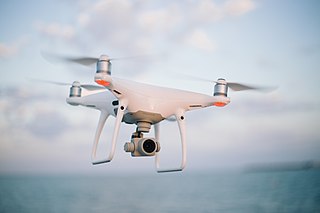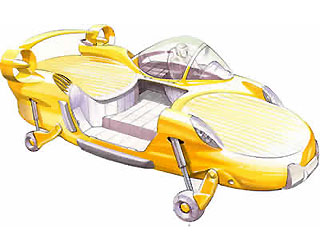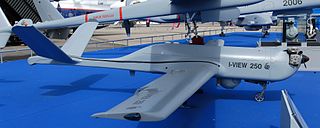
The Bell X-22 is an American V/STOL X-plane with four tilting ducted fans. Takeoff was to selectively occur either with the propellers tilted vertically upwards, or on a short runway with the nacelles tilted forward at approximately 45°. Additionally, the X-22 was to provide more insight into the tactical application of vertical takeoff troop transporters such as the preceding Hiller X-18 and the X-22's successor, the Bell XV-15. Another program requirement was a true airspeed in level flight of at least 525 km/h.

The FanWing is an aircraft configuration in which a horizontal-axis cross-flow fan is used in close conjunction with a fixed wing. The fan forces airflow over the fixed surface to provide both lift and forward thrust.

A miniature UAV, small UAV (SUAV), or drone is an unmanned aerial vehicle small enough to be man-portable. Smallest UAVs are called micro air vehicle.

The Boeing A160 Hummingbird is an unmanned aerial vehicle (UAV) helicopter. Its design incorporates many new technologies never before used in helicopters, allowing for greater endurance and altitude than any helicopter currently in operation.

A quadcopter or quadrotor is a type of helicopter with four rotors.

The EADS Barracuda is a jet powered unmanned aerial vehicle (UAV) currently under development by EADS, intended for the role of aerial reconnaissance and also combat. The aircraft is a joint venture between Germany and Spain.

The Elbit Hermes 450 is an Israeli medium-sized multi-payload unmanned aerial vehicle (UAV) designed for tactical long endurance missions. It has an endurance of over 20 hours, with a primary mission of reconnaissance, surveillance and communications relay. Payload options include electro-optical/infrared sensors, communications and electronic intelligence, synthetic-aperture radar/ground-moving target indication, electronic warfare, and hyperspectral sensors.
Rafi Yoeli, Ph.D., is an Israeli pilot, inventor, designer of two proposed flying cars, and CEO of Urban Aeronautics Ltd., which he founded in Yavne, Israel in 2000.

The Aeronautics Defense Dominator is an Israeli Medium-Altitude Long-Endurance (MALE) unmanned aerial vehicle (UAV) manufactured by Aeronautics Defense Systems. It is based on the Austrian Diamond DA42 Twin Star passenger aircraft. Dominator UAV executes intelligence, surveillance and reconnaissance (ISR) operations.

The Urban Aeronautics X-Hawk is a proposed flying car designed by Rafi Yoeli in Yavne, Israel, being built by Metro Skyways Ltd., a subsidiary of Yoeli's privately held company, Urban Aeronautics. The firm claims to have flown the car to a height of 90 cm (3 ft), and that greater heights are possible. The X-Hawk and its smaller unmanned version, the Tactical Robotics Cormorant, would be used in search and rescue operations where a helicopter would be useless, or at least very dangerous, such as evacuating people from the upper stories of burning buildings, or delivering and extracting police and soldiers while very close to structures, narrow streets, and confined spaces, with a projected size similar to that of a large van.

The IAI I-View is a small reconnaissance unmanned aerial vehicle developed in Israel in the early 21st century. Like other UAVs produced by IAI, it has fixed landing gear and an 18.6 kW (25 hp) piston engine. The Eye-View is also being promoted in civilian markets for forest fire warning, and in this form is appropriately known as the FireBird.

The IAI Eitan is an unmanned reconnaissance aircraft developed in Israel in the early 21st century by the Malat division of Israel Aerospace Industries. The aircraft is a newer version of the IAI Heron.

Aurora Flight Sciences is an American aviation and aeronautics research subsidiary of Boeing which primarily specializes in the design and construction of special-purpose Unmanned aerial vehicles. Aurora has been established for 20+ years and their headquarters is at the Manassas Regional Airport in Manassas, Virginia.

The Aerial Reconfigurable Embedded System (ARES) was a concept for an unmanned VTOL flight module that can transport various payloads. The concept started as the TX (Transformer) in 2009 for a terrain-independent transportation system centered on a ground vehicle that could be configured into a VTOL air vehicle and carry four troops. ARES' primary function was the same as TX, to use flight to avoid ground-based transportation threats like ambushes and IEDs for units that don't have helicopters for those missions. It was to be powered by twin tilting ducted fans and have its own power system, fuel, digital flight controls, and remote command-and-control interfaces. The flight module would have different detachable mission modules for specific purposes including cargo delivery, CASEVAC, and ISR. Up to 3,000 lb (1,400 kg) of payload would be carried by a module.

The Israel Aerospace Industries Panther is a tilt-rotor unmanned aerial vehicle (UAV) produced by Israel Aircraft Industries in Israel.
The Airbus CityAirbus is a multinational project by Airbus Helicopters to produce an electrically-powered VTOL personal air vehicle demonstrator. It is intended for the air taxi role, to avoid ground traffic congestion.

An unmanned surveillance and reconnaissance aerial vehicle, is an unarmed military UAV that is used for intelligence, surveillance, target acquisition, and reconnaissance (ISTAR). Unlike unmanned combat aerial vehicle (UCAV), this type of system is not designed to carry aircraft ordnance such as missiles, ATGMs, or bombs for drone strikes. The main purpose is to provide battlefield intelligence. Small sized short-range man-portable unmanned aerial vehicles are called miniature UAV also used for battlefield intelligence. s
The General Atomics Sparrowhawk is an unmanned parasite aircraft currently being developed by General Atomics Aeronautical Systems (GA-ASI). First disclosed in 2019 and revealed to the public in September 2020, the Sparrowhawk is intended to offer the United States Air Force a Small Unmanned Aerial System (sUAS) capable of SIGINT/ELINT, ISR, radar imaging, jamming and the possibility for future roles.















